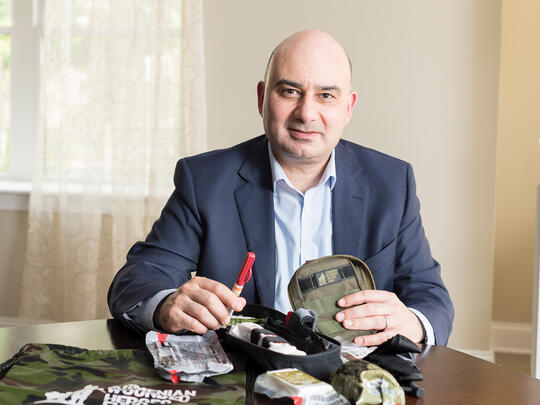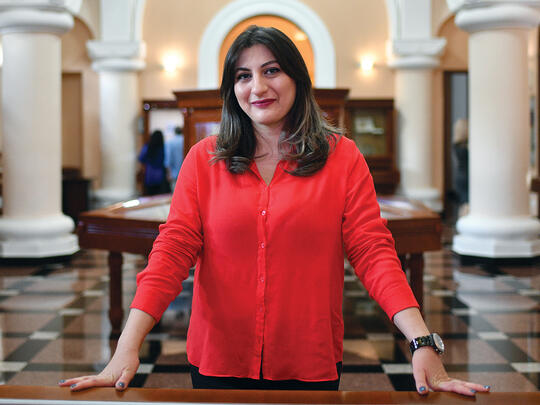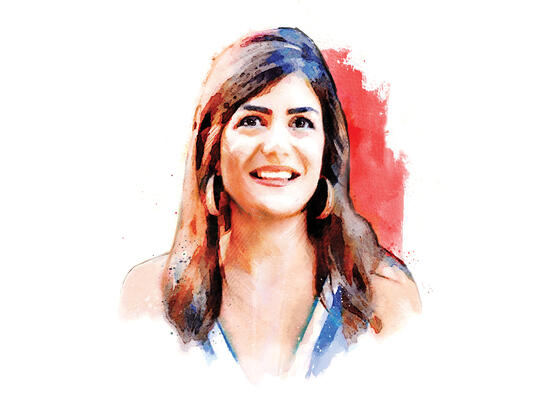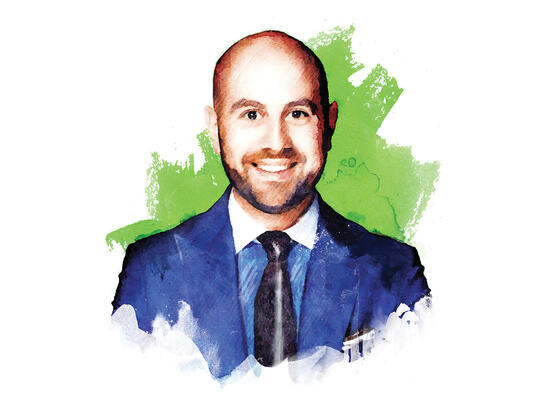Behind every success story, there is a plan. Or is there?
For graphic designer Steve Altan, the opposite seems to be true. “I’ve never gone out with a plan,” he insists. “I like being spontaneous and seeing where the experience will lead me.”
As a unique talent more inclined to overdo than to overthink, Altan has managed to build a flourishing career and prolific body of work by virtue of his readiness to open doors. As he tells it, “Success has a lot to do with just putting yourself out there. It’s just showing up to things that you might be uncomfortable with. I never had that fear of the unknown.”
Such an uncalculated approach to making a name in a highly competitive field has nonetheless propelled Altan to the far corners of the art world, as a graphic artist, fashion designer, advertising, marketing, and branding specialist, not to mention fine artist. He also created his own signature clothing line called Rock Beats Paper® while working full time for OuterStuff®, a youth apparel company that holds licenses for brands such as Umbro, Nike, and Mitchell & Ness, as well as major league sports—from the NBA, NHL, and MLS to Team U.S.A.
He would be the first to agree that his innate versatility and self-confidence have enabled him to escape the fate of many of his peers, who are one product or industry category away from being typecast into a rut. He also prides himself on making and keeping connections with those who hold the keys to the next door of opportunity, be it his art professors, creative collaborators, co-workers, or clients. What’s more, his refusal to compartmentalize his skills also casts a wider net, keeping his creative options open.
Success has a lot to do with just putting yourself out there. “It’s just showing up to things that you might be uncomfortable with. I never had that fear of the unknown.
“I can’t go with the status quo,” says Altan. “Even here at Outerstuff, I wear many hats. When they hired me, I told them, ‘I’ll do whatever you want. Just keep it interesting and don’t pigeonhole me into one particular thing, because that just won’t work for me.’”
What does work is Altan’s visual sensibility and multicultural sensitivity, which particularly resonate with today’s urban youth demographic that strongly identifies with music and sports icons. Designing for pop culture celebrities with their own labels—from Daymond John (Shark Tank), the rapper Nelly, and the basketball great Allan Houston to film superstars such as Jaden and Will Smith—has polished Altan’s sterling reputation for creating stand-out designs as original and bold as they are mass-marketable in global retail chains such as Macy’s and Forever 21, as well as apparel websites across the Internet. His sartorial skills seem to be in his DNA, as both his father and uncle made a new life in America by way of the clothing industry.

Born in Istanbul, Turkey, to Armenian parents, Altan arrived in New York at just three months old. The family settled in Queens, New York—often referred to as the world’s most diverse melting pot. His first five years were spent in the neighborhood of Sunnyside, a magnet for newly arrived Armenian immigrants. “I was surrounded by all my ‘aunts and uncles’ who lived in our building,” recalls Altan. “We lived across the street from a park in which Armenians from all over the world would gather as one big family.”
Thus Altan’s Armenian identity was imprinted for life along with his budding identity as an artist. An only child, he occupied his time making drawings derived from the fantasy world of comics. “I would spend lots of time in comic book stores or at the library,” Altan noted. “Or I would rent videos and hit pause, then sit there and draw what I saw on screen.”
Altan mused over how, as a youth, he took his talent for granted and wasn’t the most well-behaved teenager. “I was getting into a little bit of trouble. At a certain point, my cousin, who had attended Camp Nubar the year prior, intervened. She suggested that I come out there to work.”
True to form, the 17- year old was open to it. “I worked in the kitchen the first of the two summers there,” he recounted. “Camp gave me lots of freedom and, every break I got, I would find myself in the arts and crafts room or sitting in nature and drawing. Acting was also something that I wanted to do. We would perform many skits for the kids at night, play music and sing songs. When there was a banquet or performance, I would help paint the backdrops.”
Reflecting on the transformative experience camp turned out to be, Altan declared, “I can honestly say that Camp Nubar was the best decision I made in my early life. It really changed me. Coming from the city and going to the middle of the woods was a bit of a culture shock for me. But it put me in touch with my creative side.”
By the time his friends were off to college, Altan had decided to pursue his art on his own terms, making new friends in the art scene of the East Village in New York in a freeform Jack Kerouac and Allen Ginsberg tradition. “Throughout my 20s, I guess you could say I was a starving artist,” Altan acknowledged. “I wrote. I played music. I painted. And I worked odd jobs. I would hang out with many creative types and we influenced one another.”
Manhattan, just across the East River, was a familiar beat for him. Since age 15, he would help out in summers and on weekends at his father’s tailoring and men’s suit shop on Madison Avenue. Altan quipped, “It’s funny; to this day I still wear ripped jeans and he still wears suits every day.”
At the time, Madison Avenue was the capital of the advertising industry, drawing many agency executives to the shop—a chance for Altan’s father to establish a few good connections of his own. Recognizing that his gifted son was floundering, he asked if they could meet with young Steve about a career in advertising. Open to hearing more, the boy received a piece of life-changing advice—get a computer.

With a desktop of his own, Altan’s creativity soared; not for designing ads but for making art. Teaching himself how to use Adobe Photoshop and Illustrator software, he began to experiment with multiple styles and techniques. He created portraits of famous rock stars and sports icons, shaping what was to become his signature style, influenced by his early love of punk rock and hip-hop music.
Ready for the next step, Altan enrolled at Queensboro College to study fine arts, working with “some of the greatest art teachers that I could ever find in my life.” He took a painting class with Paul Schinkel, a professor who also produced a television documentary series called Art New York. Schinkel interviewed many famous artists, some of the biggest names such as Roy Lichtenstein and Jean-Michel Basquiat. “He told me I had a style similar to Picasso’s, but very uniquely mine. Of course, as soon as he said ‘Picasso’, I tried to go in a different direction,” Altan recalled, quickly adding, “I really admire Picasso, but I don’t want to be compared to anybody else.”
On the cusp of his 30th birthday, Altan began to get practical and actually made a plan that, ironically, backfired. He applied to the Fashion Institute of Technology (FIT) to study graphic design, but was roundly rejected. “That was a first for me,” admitted Altan. “I didn’t have the graphic design portfolio they were looking for.”
Ever the optimist, he found an alternate route—the FIT continuing education track. There he not only earned credits in graphic design, but also the admiration of his instructors who, just as before, became his mentors. “We formed friendships and became collaborators. I applied to FIT again, and this time, I had the portfolio and teacher recommendations it was looking for.” It was during his third year at FIT when another door opened.
One of Altan’s side jobs was inspecting cars on Long Island. One day a customer who owned a toy company asked him if he had other aspirations, to which Altan replied he was studying graphic design. The customer asked if he knew package design. “I said sure, even though I had only taken one course,” Altan points out. “But, after the interview, they hired me on the spot. It was my first exposure to what they call the ‘business of art.’”
Walking through that door turned out to be a big adjustment for Altan, who was accustomed to creating art for art’s sake. As he slowly came to terms with it, a new cycle of opportunities came his way, the first of which was a position at a loungewear company, designing boxer shorts for kids. Learning the ropes of fashion design ultimately led to his long-time role as an art director for a popular fashion company called Apple Bottoms.

It was there that Altan became the darling of the celebrity-label niche, which opened doors in streetwear. Through Nelly, the American rapper, songwriter, and entrepreneur turned fashion icon, Altan was able to wow the Nelly team with his unique aesthetic, influenced by his personal affinity for hip-hop, punk, and classic rock genres. “I brought all those elements into play, working on the marketing side while designing apparel.” With Altan’s mastery of Photoshop, he was also able to design ads for top magazines such as Vibe, The Source, and Seventeen. “We turned Apple Bottoms into an almost $100 million brand in a couple of years,” Altan reported with satisfaction.
Today, working on a high-octane schedule and juggling the constant demand for his talent with his personal life as husband and father, Altan has made peace with the contradiction between artistic purity and business reality. Altan sums it up, saying, “I look at it as art serving capitalism. When art is your lifelong passion, it eventually has to become a business. That’s a growing point.”
Thanks to his open personality, boundless originality, technical agility, and, admittedly, plain good fortune, many doors have opened to Steve Altan throughout his illustrious career. Yet he has no idea what door comes next. And that suits him just fine.
Banner photo: Steve Altan in front of a store on Orchard Street in the Lower East Side of New York where he got his start as an artist. Photo by Adam Kane Macchia

















